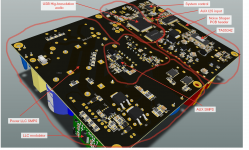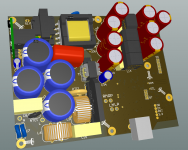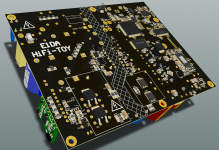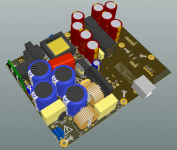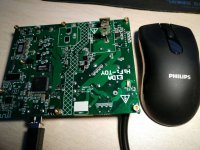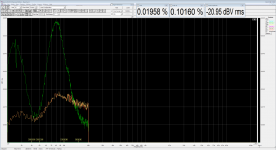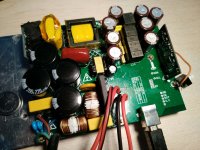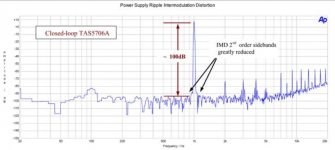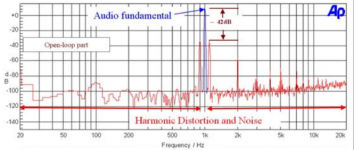Hi there, I keep working on firmware so far, next step is IOS/Android apps. However, I can't stop thinking about the amp modification for tas5558+TAS5342LA(is there any other open-loop candidate?) with custom noise shaper. It looks quite easy in a simulation, at least for THD<.01% over audio band (equal for 100/1000/6000Hz). I don't know, maybe 15 years ago mr. J. Westlake spent a lot of efforts to get .00000% with ti/sony modulator + custom noise shaper + custom power stage but today get <.01% with tas5558+TAS5342LA looks easy, if not say trivial  Let's try, only the size is an issue, I really wish to keep the same tiny format and 2x100W to get real Hi-Fi amp..
Let's try, only the size is an issue, I really wish to keep the same tiny format and 2x100W to get real Hi-Fi amp..
with custom noise shaper
noise shaper=integrator?
I never sold anything before, only entire designs. However, selling today getting so easy so probably I'll try order couple thousand units and establish a taobao shop for it. I had the discussion, couple weeks ago, with some marketing people from CA regarding that tiny and uncompromised Hi-Fi amp, they don't believe for any success of such form factor and refers to their experience of work with the North American market. Ok, but I personally also don't believe if the fact of 30 years of a passive observing of the audio market helps anyone to predict new trends on it. Especially if you were always secondary and only improves your ability to follow the market wants and makes products cheaper and cheaper. Such kind of people never finds something new, like S.J. found iPhone 2007, simply because "market" didn't know about the iPhone in 2006. For example, those marketing people recommend me to use that amp for a wireless active speakers "because of it's what market wants - wireless world!" )) Hell, I'm not a market member obviously, I don't need active wireless junk again, probably because I don't laugh at the same joke 10 years. And "wireless active speaker" today is a wired system yet! Usually, it is two speaker box, one is active second is passive and wire between + AC power wire. So whom we try to deceive? )) I believe, people buy something new, even if it's not really useful - the idea should contain novelty. For instance, why Apple Inc. makes power bricks for their laptops 50% smaller size than HP? Because HP's power bricks practically are too big? Nope, Apple just can make it smaller and do that because it has a sign of future, it looks more sexy, automatically, without extra advertising spent.
a noise shaper is the same thing as a loop-filter or an extra-integrator(as Bruno P. call it). BTW, further simulations confirm that the idea of partial feedback after LC filter is quite real too. It's doesn't help a lot regarding THD, but makes +/-.5db frequency response in the range of loads 4..8ohm.
Last night I've lost all hopes regarding routing options of the tas5558, and I decides to go with default DSP chain: 7 pEQ/ch, Shelving, Loudness, Compressor/Limiter. Sorry.
Currently thinking about 7 pEQ GUI. Sure it will look the same like iWoofer: YouTube
However, need to prepare logic for dynamic biquads alocation. I think a good idea to use one more position for LPF/HPF order switching logic, you can see that in the video above 0:07-0:09. The vertical slide changing LPF's order, and minimal order will mean the LPF is Off, the same time few additional free pEQ well appeared instead of the LPF. Tyoma (the coder) likes another approach, he want's to add in Options page editable 7 biquads configurator, something similar to SigmaStudio GUI. Any opinions on it, guys?
Currently thinking about 7 pEQ GUI. Sure it will look the same like iWoofer: YouTube
However, need to prepare logic for dynamic biquads alocation. I think a good idea to use one more position for LPF/HPF order switching logic, you can see that in the video above 0:07-0:09. The vertical slide changing LPF's order, and minimal order will mean the LPF is Off, the same time few additional free pEQ well appeared instead of the LPF. Tyoma (the coder) likes another approach, he want's to add in Options page editable 7 biquads configurator, something similar to SigmaStudio GUI. Any opinions on it, guys?
doctormord, the LLC uses 105..190kHz range, and trafo(sandwich type to reduce proximity effect) with external coil. A higher idle frequency may affect an S/N, so I stopped on 185-190kHz, I doing there some frequency shuffling to make bit tones(vs 384kHz) a noise like. That also good for EMI performance.
Icg, the external BT antenna is quite big for such compact design, so I prefer plastic rear panel and PCB antenna.
irs20957, yep, it is good example of typical chinese design i.e. a bigger size with no SMPS onboard + external power brick adaptor rather for LCD monitor than for audio purpose. That's not HiFi at all, in my opinion.
Icg, the external BT antenna is quite big for such compact design, so I prefer plastic rear panel and PCB antenna.
irs20957, yep, it is good example of typical chinese design i.e. a bigger size with no SMPS onboard + external power brick adaptor rather for LCD monitor than for audio purpose. That's not HiFi at all, in my opinion.
That's not HiFi at all, in my opinion.
I agree with your opinion
I've got 2 days extra because of the weekend, so I keep improving the PCB just can't stop ))
1) size is reduced again, now 127x100mm
2) two status LEDs are placed on the edge of the PCB to work with light-pipe
3) finalized silk
1) size is reduced again, now 127x100mm
2) two status LEDs are placed on the edge of the PCB to work with light-pipe
3) finalized silk
Attachments
Just finished the new PCBA 127x100x30mm. Unfortunately, SMPS DPAK mosfets are only fake on Taobao, so I have to start with TO220 until getting std18n55m5. What I noticed right away with open loop Ti power stage(tas5342), it is crazy hot even if idle. For sure tas5342 has less dead time vs closed loop tas5624.
Attachments
Hi there, I didn't finish the noise-shaper adjustment yet but can't resist and I've listened the amp in both modes(open loop/closed loop). The first impression was - hey, it sounds just the same open or closed loop whatever. However, my wife petty sure if open loop mode makes more bass. It was a bit strange because she said that just by the way, without deep involving to the listening process. I tried to hear the bass difference and played some fine bass tracks, and indeed the open loop sounds a bit more boomy and more punchy. I've tested frequency responses and found some really homeopathic difference(see attached). I guess the reason is output impedance difference for open and closed loop mode. Also, I think I hear the difference, not really about frequency responses but rather my SMPS dynamic response. In a highs both modes are pretty much equal, however, if listening level getting up(actually it should be quite loud), some sounds(sax, vocals) a bit losing transparency, becomes too smooth. I believe it is about THD+N which become huge in open loop mode(.2-.5% @ 1/2 max power). The amp is crazy hot(55C) on the 166x100x5mm aluminum lamina, even idle. No idea what to do with heatsink..
Attachments
Guys(if anyone still reading my nonsense stream), I keep listening the amp, and yes, open loop mode sounds more pleasant, I'm sure. It is more relaxed and not so tight and not so refined as the closed loop. Open loop mode sounds less boring, less dry  I asked my wife make for me A/B blind test, and I picked to the open loop sound with no doubt. Oh hell, 100 times less THD sounding worse ))
I asked my wife make for me A/B blind test, and I picked to the open loop sound with no doubt. Oh hell, 100 times less THD sounding worse ))
- Status
- This old topic is closed. If you want to reopen this topic, contact a moderator using the "Report Post" button.
- Home
- Amplifiers
- Class D
- Tiny TAS5558 +TAS5624 "Power_DAC"+SMPS
